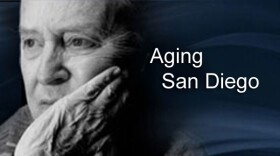The Centers for Disease Control says nearly half of all deaths in the U.S. take place in a hospital.
That’s despite the fact that hospice care is widely available, and is covered by Medicare.
San Diego’s oldest hospice is trying to raise awareness about end-of-life options.
On the third floor of a Mission Valley department store, an educational program for older adults hosts a session on hospice care.
Speaker Ken Lowe explained the basic philosophy.
"No one should live in pain," Lowe said from the podium. "No one should live in fear. No one should die feeling alone."
Lowe told the audience hospice is designed for people who are given less than six months to live. It focuses on managing symptoms, relieving pain, and providing emotional and spiritual support. What’s more, Medicare and private insurers pick up the tab.
Lowe said despite these benefits, he’s constantly surprised at how little people know about hospice.
"They don’t have a clue," he said. "They don’t even have a clue as to what hospice care is, in other words, what it means to them as a caregiver. It’s amazing."
One of the challenges with spreading the word about hospice care is that it deals with dying.
And that’s an uncomfortable subject for most Americans.
Dr. Stephen Oppenheim is chief medical director at the San Diego Hospice. He said it's different in some of other parts of the world.
"Well, there are many countries, many of them developing countries, where death seems to be embraced more as an integral part of life," Dr. Oppenheim pointed out. "It’s harder in America, I think, for many of us to acknowledge that part of life."
Dr. Oppenheim believes the discomfort people have in talking about death fuels myths about hospice care.
"Some of the misperceptions are that it’s like giving up when you go into hospice, when actually hospice care is a way to improve the quality of life," he continued. "There are misperceptions that when people go to hospice that somehow death is accelerated, and in fact we have a growing evidence base that people live longer with hospice care in the setting of terminal illness."
The process of placing someone in hospice care begins with a referral from a doctor.
Dr. Gary Buckholz directs the fellowship program at the San Diego Hospice Institute for Palliative Medicine. He said some physicians have a tough time bringing up the subject.
"I think it’s a really challenging conversation to have, and I think that’s why often, it’s delayed," he said.
The institute trains physicians in palliative care, which focuses on relieving suffering, and enhancing quality of life.
Dr. Buckholz thinks physicians need to be ready to talk about end-of-life options.
"I think sometimes the patient or a family member ends up asking the question," Buckholz said. "And we would love to see physicians developing more comfort in bringing the topic up. It’s really what the patients and families want."
The San Diego Hospice cares for about 1,200 people a day in their homes throughout San Diego County. It also has the capacity to treat up to 24 patients at its inpatient care center in Hillcrest.
After a brief stint at the center, 79-year-old Sadie Jacobs will go back home. That’s where the vast majority of hospice patients spend their final days.
Jacobs said if she could talk to people who are worried about hospice…
"I’d tell ‘em it’s the best place they could ever be in their life," she said. "They don’t have to worry about themselves. People here is concerned about you, and not theirself. And I’d tell ‘em they’d feel comfortable. It’s the best place they ever could go besides Heaven.”
There are 16 different hospice programs in San Diego County.








